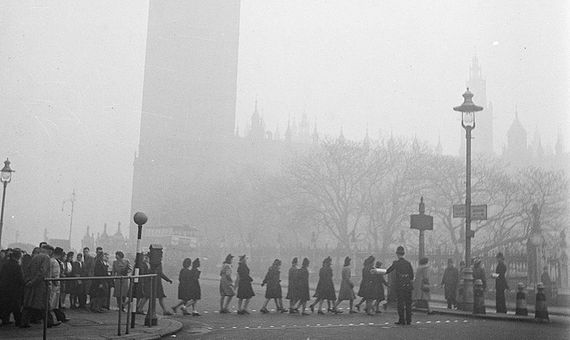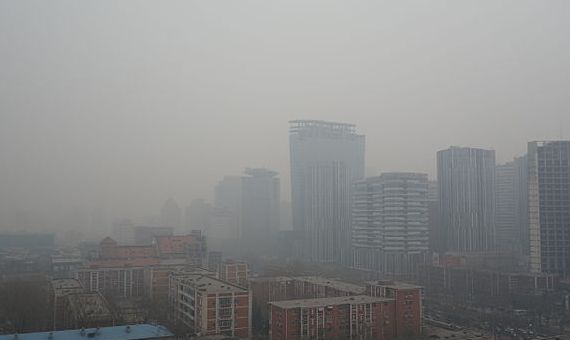According to textbooks, the Earth’s atmosphere is composed of 78% nitrogen (N2), 21% oxygen (O2), 0.9% argon and 0.1% other gases, including 0.04% carbon dioxide (CO2). These are rounded figures. And, barring a planetary catastrophe, it is not foreseeable that the books will have to be updated any time soon. But it’s a different story when you add more decimal places: according to the Encyclopaedia of Geology, since the Industrial Revolution CO2 has increased from 0.0385% to 0.0414%, which has reduced the oxygen from 20.9435% to 20.9406%. Other pollutants have also increased slightly as a result of human activity, such as nitrogen oxides (NOx), sulphur dioxide (SO₂), carbon monoxide (CO), ozone (O₃) and particulate matter. But considering that, according to the World Health Organization (WHO), 99% of humans breathe polluted air that is linked to seven million deaths a year, it is understandable that the United Nations describes air pollution as “the most important environmental health risk of our time.”
A few years ago, the media reported a surprising trend. While we already knew about the denialism of lunar missions, climate change and vaccines, we now learned about the denialists of atmospheric pollution, or, more precisely, of its effects on health. The news hook was the presence of advocates of this argument among the high-ranking members and advisors of the US Environmental Protection Agency (EPA) appointed by then-President Donald Trump. However, this was not really a new trend: one of these advocates, University of California at Irvine professor Robert Phalen, told the American Association for the Advancement of Science in 2012 that “modern air is a little too clean for optimal health.” Nor is this restricted to the US: in India, Poland and Spain, voices have also been raised denying the link between air pollution and mortality.
From Greece and Rome to the Industrial Revolution
The truth is that concern about air quality long predates the Industrial Revolution, the age when it began to become a major problem. Probably the earliest reference is attributed to Hippocrates, who around 400 BC related illness to air quality in his work Airs, waters and places. The father of medicine said that inhabitants of cities exposed to damp westerly winds had deep, hoarse voices because of the impure and unhealthy air. Somewhat later, Roman authors such as Seneca speculated on the negative effects of smoke from cooking stoves in cities. To the east, Arab and Chinese authors warned of the risks caused by smoke from burning coal. In England, the first legislation against coal due to the health hazards of smoke was introduced in 1273, the Smoke Abatement Act.

With the advent of industry, concern about air pollution gained momentum, especially in large cities such as London, where in the 17th century John Evelyn published Fumifugium, or, The Inconvenience of the Aer and Smoak of London. Although the effects on health were not yet known in detail, a correlation between pollution and mortality was intuited, so Evelyn suggested moving industries out of urban agglomerations. Thus, as the Industrial Revolution began to generate large emissions of CO2, SO2, NO2 and ammonia (NH3), there was also growing concern about their impact on human health. But the tipping point did not come until the so-called Great Smog of London in 1952, when an increase in coal use due to cold weather, coupled with certain weather conditions, blanketed the British capital in early December with a dense haze of pollution that even prevented car traffic.
An estimated 12,000 people died as a result, mostly children, the elderly and people with respiratory problems, and 100,000 more fell ill. The public policy reaction was the Clean Air Act, introduced in 1956. At the same time, other countries were also beginning to regulate air quality by closing facilities, relocating others and seeking greater efficiency. As a result, between 1962 and 1975, ambient concentrations of smoke and SO2 fell by 60% in London. Across Europe, SO2 emissions peaked in the 1980s. Until 1970, the old continent and North America were the main emitters of air pollutants, accounting for more than 80% of the global total.
Pollution and mortality, one of the most studied phenomena
Around the same time, the long-range transport of pollutants, responsible for phenomena such as acid rain, and its effect on forests was also recognised. In the 1990s, another major threat began to be identified, namely fine particulate matter (PM), which is usually classified as particles less than 10 microns (PM₁₀) and less than 2.5 microns (PM2.5). In 1993, a Harvard study known as the Six Cities Study showed a strong correlation between pollution levels and life expectancy, revealing that people resident in cities with high levels of PM2.5 lived two to three years less than those in cleaner cities. Today it is estimated that PM2.5 is responsible for 4.2 million premature deaths and the loss of 100 million years of life worldwide each year, even in atmospheric conditions generally much better than London’s Great Smog.

But, in the face of the arguments by denialists, to what extent has this link between air pollution and mortality, which the UN says is responsible for one in nine deaths, been proven? Since the Six Cities Study, thousands of studies have corroborated this link; according to what María Neira, director of the WHO’s Department of Public Health, wrote in the newspaper El País in December 2020, there are more than 70,000 such studies. Lung health and air pollution expert Janice Nolen told The New Republic that this is one of the most and best researched topics in the scientific world. According to New York University professor of medicine and environmental health George Thurston, co-author of the air pollution report in the international Global Burden of Disease study, the science on air pollution is even stronger than that on climate change, he told Unearthed—Greenpeace’s investigative journalism project in the UK.
However, as Unearthed also explained, it is worth clarifying that agency estimates of deaths attributed to air pollution, which are mainly caused by cardiovascular crises or respiratory diseases—in 2013, the WHO also included this factor as a cause of cancer—take into account the total burden of the effect of this factor on the life years of the population. Thus, the estimated death figures published are actually a way of expressing the effect on the life expectancy of the population, as in the Harvard study: when talking about 29,000 deaths in the UK due to PM2.5, this represents a loss of 11.5 years of life for these people, which can also be expressed as the loss of 340,000 total years, or an average of three days per member of the population.
Small steps towards cleaner air
In the face of the seriousness of the problem, legislation adopted in developed countries has led to a 90% drop in SO2 emissions in Europe and North America by 2016 from their peaks in the 1970s and 1980s—and NO2 and PM emissions by more than 50% since the 1990s. However, China and South Asia took over as the most polluting regions, which on net balance resulted in only a 15% overall reduction for SO2, while NO2, ammonia and PM continued to increase globally. Today, the biggest problems comparable to the Great London Smog of 1952 affect cities in countries such as China and India. Thus, despite progress in developed countries, global air pollution has continued to grow, although today the greatest burden is borne by emerging or developing countries. According to the WHO, 91% of premature deaths due to air pollution are concentrated in low- and middle-income nations, particularly in Asia.

Awareness of climate change has also helped spread regulations that promise to mitigate environmental pollution. Even China, which preaches a strong climate commitment, has managed in recent years to lessen its SO2 and NO2 emissions. Some experts look to the future with hope: according to a review published in 2020 in Philosophical Transactions of the Royal Society A, “the world has passed the point of maximum emissions of several major gaseous air pollutants…” However, it added that we should “be cautious, because emissions of ammonia, an important contributor to PM […], continue to rise, and possible feedbacks between emissions of these gases and climate may drive overall emissions upwards.”
In 2021, the WHO has updated the air quality thresholds for the first time since 2005, resulting in more stringent levels than before. But while we trust that the most optimistic forecasts about the possible reduction in air pollution for the coming decades will be met, there is one thing we must not forget: even if the region where we live is below the maximum levels of gases recommended by the WHO, this agency reminds us that for fine particulate matter, the greatest scourge to our health, the guidelines only try to minimise the risk, as there are no safe levels: “no threshold has been identified below which no damage to health is observed.”
Comments on this publication